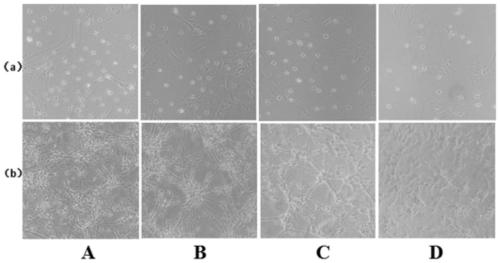Quad-synapsis complex cell model of diabetic concurrent depression and building method and application thereof
A technology of cell model and establishment method, applied in the field of cell model, which can solve the problems of insufficient simulation of in vivo environment and difficulty of real response
- Summary
- Abstract
- Description
- Claims
- Application Information
AI Technical Summary
Problems solved by technology
Method used
Image
Examples
Embodiment 1
[0044] The cell models after co-cultivation for 3 days were randomly divided into normal control group, high glucose group, corticosterone group, and model group. Multiple wells were set up in each group, and corresponding intervention drugs were added according to the above grouping details, among which the high glucose group was added Glucose at a final concentration of 150 mM, corticosterone at a final concentration of 200 μM was added to the corticosterone group, and glucose at a final concentration of 150 mM and corticosterone at a final concentration of 200 μM were added to the high-glucose combined corticosterone group for 18 hours. The general morphology of hippocampal neurons, astrocytes and microglia under intervention conditions were observed separately.
[0045] The experimental results showed that in the normal control group, the NE cell body was round and bright, with good gloss and refraction, with criss-cross protrusions and numerous small branches, which were i...
Embodiment 2
[0047] Enzyme-linked immunosorbent assay (Elisa) was used to detect the contents of neurotransmitters NE, DA, and 5-HT in hippocampal neurons to evaluate whether the tested cells produced depression-like indicator characteristics. The specific operation is as follows: After co-cultivating the cell model for 3 days, the cells were divided into normal control group, high glucose group, corticosterone group, high glucose combined with corticosterone group, and each group was set with 4 replicate wells. The high-glucose group added glucose with a final concentration of 150 mM, the corticosterone group added corticosterone with a final concentration of 200 μM, and the high-glucose combined corticosterone group added glucose with a final concentration of 150 mM and corticosterone with a final concentration of 200 μM. Wash 3 times with cold PBS, add RIPA cell lysate containing PMSF, inoculate on a sterile ice box at 4°C for 1 hour, centrifuge at 12000 for 15 minutes, collect the super...
Embodiment 3
[0053] Inoculate hippocampal neurons into a 96-well plate, and inoculate mixed glial cells into another 96-well plate at the same time, wait for the cells to grow to 5-7 days, and when the neural network and glial cells grow to about 80% confluence respectively , except that the blank control group was given the same amount of maintenance medium, the corresponding concentrations of high glucose (150mM) and corticosterone (200μM) were added to the glial cells of the other groups, and three replicate wells were set up in each group. After 18 hours of modeling intervention, , take the supernatant to neurons, and then incubate in a 37°C incubator for 18h. Add 20 μL MTT to each well, act for 4 hours, discard the liquid, add 150 μL DMSO to each well, shake on a horizontal shaker for 15 minutes, and finally measure the OD value of each well with a microplate reader at a wavelength of 492 nm, and calculate the relative survival rate of cells in each group .
[0054] The results showe...
PUM
 Login to View More
Login to View More Abstract
Description
Claims
Application Information
 Login to View More
Login to View More - R&D Engineer
- R&D Manager
- IP Professional
- Industry Leading Data Capabilities
- Powerful AI technology
- Patent DNA Extraction
Browse by: Latest US Patents, China's latest patents, Technical Efficacy Thesaurus, Application Domain, Technology Topic, Popular Technical Reports.
© 2024 PatSnap. All rights reserved.Legal|Privacy policy|Modern Slavery Act Transparency Statement|Sitemap|About US| Contact US: help@patsnap.com










